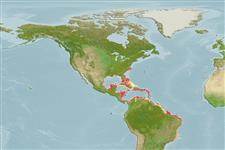Teleostei (teleosts) >
Blenniiformes (Blennies) >
Blenniidae (Combtooth blennies) > Salariinae
Etymology: Parablennius: Greek, para = the side of + Greek, blennios = mucus (Ref. 45335).
More on author: Poey.
Environment: milieu / climate zone / depth range / distribution range
Ecology
Marine; reef-associated; depth range 0 - 10 m (Ref. 9710). Subtropical; 36°N - 27°S, 98°W - 34°W
Western Atlantic: New York (USA), Bermuda, the Bahamas, Gulf of Mexico to southern Brazil.
Size / Weight / Age
Maturity: Lm ? range ? - ? cm
Max length : 8.5 cm TL male/unsexed; (Ref. 7251)
Facultative air-breathing in the genus (Ref. 126274); Adults inhabit eroded basins and limestone boulders covered by an algal mat, sea fans, etc. (Ref. 5521). Sometimes around mangrove roots, young are sometimes found in floating Sargassum (Ref. 26938). Omnivorous, but feed mostly on algae (Ref. 13442). Oviparous. Eggs are demersal and adhesive (Ref. 205), and are attached to the substrate via a filamentous, adhesive pad or pedestal (Ref. 94114). Larvae are planktonic, often found in shallow, coastal waters (Ref. 94114).
Life cycle and mating behavior
Maturity | Reproduction | Spawning | Eggs | Fecundity | Larvae
Oviparous, distinct pairing (Ref. 205).
Robins, C.R. and G.C. Ray, 1986. A field guide to Atlantic coast fishes of North America. Houghton Mifflin Company, Boston, U.S.A. 354 p. (Ref. 7251)
IUCN Red List Status (Ref. 130435: Version 2025-1)
Threat to humans
Harmless
Human uses
Fisheries: of no interest; aquarium: commercial
Tools
Special reports
Download XML
Internet sources
Estimates based on models
Preferred temperature (Ref.
123201): 23.5 - 28.2, mean 27.2 °C (based on 572 cells).
Phylogenetic diversity index (Ref.
82804): PD
50 = 0.5000 [Uniqueness, from 0.5 = low to 2.0 = high].
Bayesian length-weight: a=0.01096 (0.00465 - 0.02585), b=2.99 (2.81 - 3.17), in cm total length, based on LWR estimates for this Genus-body shape (Ref.
93245).
Trophic level (Ref.
69278): 2.5 ±0.23 se; based on food items.
Resilience (Ref.
120179): High, minimum population doubling time less than 15 months (Preliminary K or Fecundity.).
Fishing Vulnerability (Ref.
59153): Low vulnerability (10 of 100).
🛈
Nutrients (Ref.
124155): Calcium = 97.8 [37.6, 198.2] mg/100g; Iron = 0.951 [0.516, 1.730] mg/100g; Protein = 19.3 [18.1, 20.4] %; Omega3 = 0.208 [0.110, 0.386] g/100g; Selenium = 8.81 [4.00, 19.36] μg/100g; VitaminA = 78.6 [21.8, 279.3] μg/100g; Zinc = 1.65 [1.02, 2.60] mg/100g (wet weight);
